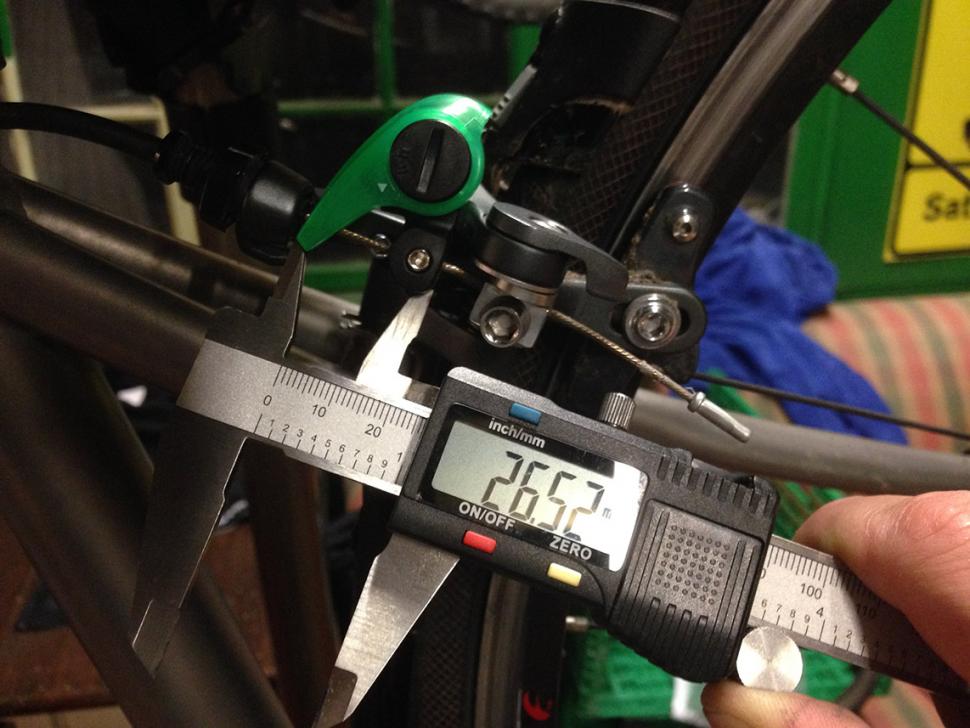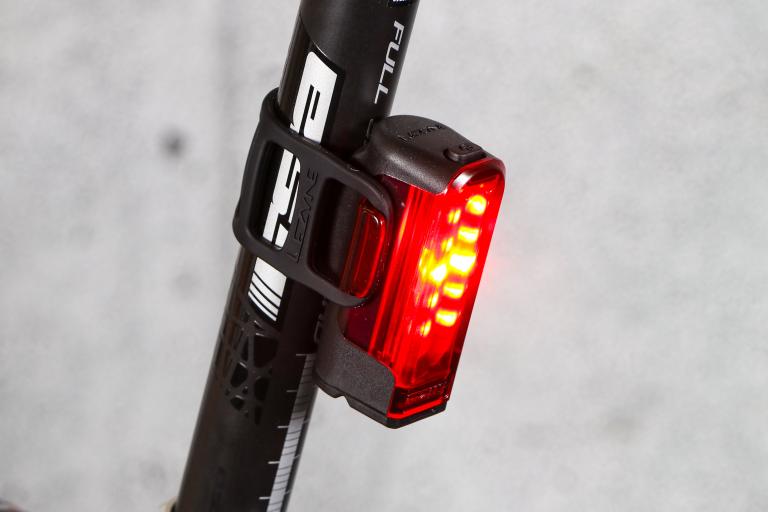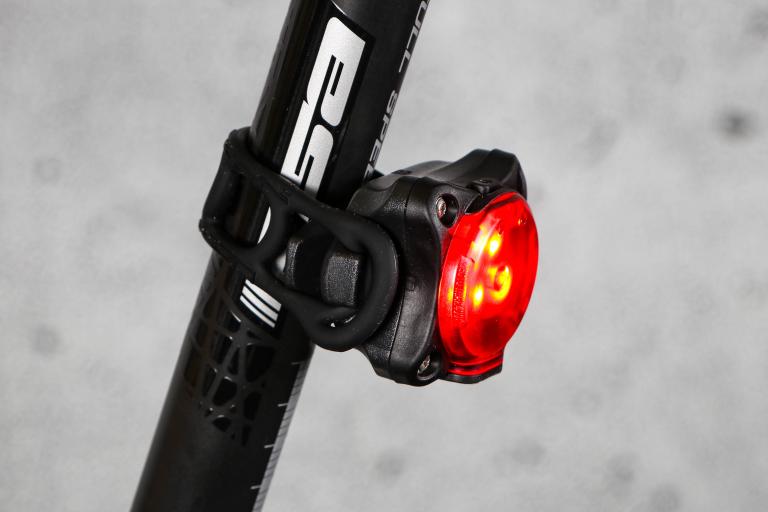- News
- Reviews
- Bikes
- Accessories
- Accessories - misc
- Computer mounts
- Bags
- Bar ends
- Bike bags & cases
- Bottle cages
- Bottles
- Cameras
- Car racks
- Child seats
- Computers
- Glasses
- GPS units
- Helmets
- Lights - front
- Lights - rear
- Lights - sets
- Locks
- Mirrors
- Mudguards
- Racks
- Pumps & CO2 inflators
- Puncture kits
- Reflectives
- Smart watches
- Stands and racks
- Trailers
- Clothing
- Components
- Bar tape & grips
- Bottom brackets
- Brake & gear cables
- Brake & STI levers
- Brake pads & spares
- Brakes
- Cassettes & freewheels
- Chains
- Chainsets & chainrings
- Derailleurs - front
- Derailleurs - rear
- Forks
- Gear levers & shifters
- Groupsets
- Handlebars & extensions
- Headsets
- Hubs
- Inner tubes
- Pedals
- Quick releases & skewers
- Saddles
- Seatposts
- Stems
- Wheels
- Tyres
- Health, fitness and nutrition
- Tools and workshop
- Miscellaneous
- Buyers Guides
- Features
- Forum
- Recommends
- Podcast
review
£9.99
VERDICT:
The Sigma Rear Brake Light is a great idea, but in practice it fails to deliver any benefit
Weight:
7g
Contact:
At road.cc every product is thoroughly tested for as long as it takes to get a proper insight into how well it works. Our reviewers are experienced cyclists that we trust to be objective. While we strive to ensure that opinions expressed are backed up by facts, reviews are by their nature an informed opinion, not a definitive verdict. We don't intentionally try to break anything (except locks) but we do try to look for weak points in any design. The overall score is not just an average of the other scores: it reflects both a product's function and value – with value determined by how a product compares with items of similar spec, quality, and price.
What the road.cc scores meanGood scores are more common than bad, because fortunately good products are more common than bad.
- Exceptional
- Excellent
- Very Good
- Good
- Quite good
- Average
- Not so good
- Poor
- Bad
- Appalling
The Sigma Rear Brake Light is a great idea, but in practice it fails to deliver any meaningful benefit.
Cars have brake lights. Huge, bright things, powered by a massive battery, that let other users of multi-ton vehicles know they are slowing down. Mounted up high as well as down low, they cut through the dark, fog and rain and work very well to alert others. They work so well, it's law to have them.
And yet people still run into the back of cars that are braking, many, many times a day. It's commonplace on UK motorways for drivers to use their amber hazard lights as an extra warning, and some new cars are coming with brake lights that flash under heavy braking, to warn following drivers that this is no ordinary slowdown. So a mixed bag: car brake lights are A Good Thing, but even with endless power on tap, and many square meters of space to fill up with light-emitting sources, they aren't perfect.
Then there's bikes. Increasingly people (self included) run lights on bikes in the daytime. Modern LED's are so small, light, bright and long-lasting that they are now viable for use on day-long rides in bright sunshine, where they greatly aid visibility in high contrast situations - for example cycling through an area of overhanging trees with sunlight lancing down through the gaps. As most cyclists are also motorists we all know how a sudden ray of sun hitting a windscreen - even a crystal-clear one - can momentarily decrease or obliterate your perception of other road users. Sometimes even with masses of care and attention you cannot anticipate this happening, and we've all had the shock of suddenly seeing a cyclist from inside a moving car.
So the advent of mega-bright 'daytime' rear lights like the highly regarded Lezyne Micro Drive, the Hope District or the See.Sense is to be applauded. I don't have stats, but I know having seen a fellow cyclist out in bright sunshine using a Lezyne like mine that they work. And at night effective lights are a legal requirement - no issues there.
> Read our latest rear light reviews
Into this ever-brighter space enters the Sigma Brake Light: A brake light, for a bicycle. Sigma aren't the first to do a light like this: iLumenox have had an almost identical product out for two years. The product video is cheesy cycling advert gold. Do seek it out. What the Sigma Brake Light purports to be is "a simple little light with a big purpose, safety. Just clip this light on your rear brake cable and it will help alert anyone behind you that you are slowing down. Perfect for kids, commuters, and group rides!". There's no 'science' here. No details, no specifications, beyond using a tiny button cell and being good for 100,000 'braking processes'. But the claim is made that it brings 'safety', and will 'help alert anyone behind you'. Anything's better than nothing, right?
Fitting for purpose
The instructions state you need 25mm of bare cable visible to fit the light. On five test bikes ranging from low-end Tektro to Dura-Ace it was a mixed bag that depended on caliper design, pad wear, rim width and the like. The light simply clamps onto the exposed inner brake cable using a 2.5mm Allen key. Curvey brake arms make it tricky, and there is some faffing with balancing barrel adjuster position against cable clamping to get a reliable fit. One fitting was (in hindsight) a bit tight, and the light exploded into pieces on the first decent squeeze. Fortunately it was reassembled complete following a detailed search of the garage floor. Once installed the lights' presence was indiscernible from normal brake lever feel.
Fit for purpose?
So does the Sigma Brake Light 'work'? In the absence of any quantifiable proofs, we are left to make our minds up based on observable factors coupled with gut feel. In this case, my firm opinion and that of my clubmates is that this device is not fit for purpose.
Firstly, it doesn't work if you brake on the front wheel. As any fule kno, roughly two-thirds of your potential braking force comes from your front wheel, and many experienced cyclists will go for the front brake before the back. So any slowing you do with the front brake will not be evident. No safety benefit there.
The raw power of a tiny button cell that claims to be good for 200 hours of continuous shining has got to be next to nothing. Certainly in a backyard test beside a decent rear light, the Sigma Brake Light was basically invisible. It was much weaker than a Lezyne Microdrive Rear on Economy (5 Lumens), even in pitch-darkness. Given the logarithmic nature of the human eye's brightness perception, I'm guessing the actual power output is a tiny fraction of one Lumen.
> Read our buyer's guide to rear lights
Taking the Brake Lights (we had five on test) out on a typical club run, it was very quickly apparent to everyone that the light is only noticeable if you are looking directly at it. If you are looking anywhere else it's imperceptible. And if there is a decent rear light in the vicinity, for example low-down on a seatpost, the Brake Light is simply swamped by its powerful neighbour. Looking directly at someone's rear brake in the hope of detecting the fact that they are slowing down is a sure-fire way to get onto the NHS Cuisine Test Team. The reality of group cycling is that the person in front is only one part of the overall picture you're taking in - cars, hedges, road surface, pedestrians, dogs, other cyclists, all these and more are flooding into your brain, requiring processing, risk-quantifying, time-space analysing for threat order/magnitude, and reacting to. You need to be looking much further afield than the rear of the bike in front, as you need to anticipate what might make him/her slow or swerve. Focusing on the likely location of a pinpoint of red LED light close-up and low-down in your field of vision in the expectation it will come on at some stage simply does not work as a safety tactic. Period. And this assumes you are within cyclist-spitting distance. A motorist will (or should) be much further back, with their own array of lights in close proximity. Any dashboard light is going to be far brighter in their eye than the Sigma Brake Light, many dozens of meters away on the other side of the windscreen.
What Sigma have done is taken a proven-good idea from the automotive world, realise there is no practical way to deliver anywhere near the same performance, and scale it down to the point of total ineffectiveness.
Cycling has a track record of hoping and believing things make you safe, without any peer-reviewed evidence to back assertions up - helmets, high-visibility vests, indicators on backpacks, the list goes on. Having read the reviews on the Sigma website, clearly many users consider themselves 'safer' or 'safe' now they have this light fitted - assuming that because it 'works' when they fit it and look at it, therefore it 'works' to make them safer. I believe, based on my own and clubmate's experience, that this is a dangerously complacent view. If you believe that cars or other cyclists will be warned of your presence or braking actions by fitting this, I think you're in error.
At risk of being labelled a hypocrite, no, I don't have any peer-reviewed proof that a high-Lumen red rear light used in bright sunlight under shaded trees makes me safer. But I have seen how good they are when driving myself, and have had drivers who also ride bikes stop and ask me what light I was using, as they wanted to buy one. As anecdotes go, that's gotta be worth something.
See.Sense blew through their Kickstarter funding goal in a few days for a light that detects braking via accelerometers and adjusts its flashing rate and brightness accordingly. Given the size and brightness involved in the See.Sense product, I believe that will 'work' as a 'brake light'- other cyclists will notice. Will drivers? maybe. A change in the flashing cycle might well be a good thing, and Mercedes think so as they offer it on their newer car models.
But in the See.Sense product we are talking of a light many, many orders of magnitude brighter, with specific wide-angle lenses. That's the kicker. Trying to make cyclists safer, using a tiny button cell and an LED drowned out by anything remotely visible nearby? I don't buy it.
Verdict
The Sigma Rear Brake Light is a great idea, but in practice it fails to deliver any benefit
road.cc test report
Make and model: Sigma Rear Brake Light
Size tested: n/a
Tell us what the light is for, and who it's aimed at. What do the manufacturers say about it? How does that compare to your own feelings about it?
The light is aimed at pretty much every cyclist using caliper brakes, to alert others to the fact you are slowing down.
Sigma says: "A simple little light with a big purpose, safety. Just clip this light on your rear brake cable and it will help alert anyone behind you that you are slowing down. Perfect for kids, commuters, and group rides! Fits u-brakes, v-brakes, cantis, road calipers, mechanical disk brakes...sorry, won't fit hydraulics!
"Attaches to cable actuated mechanical brakes with at least 25 mm clearance."
Tell us some more about the technical aspects of the light?
Functions/Features
LED brake light with replaceable CR 1025 button cell battery (included)
Clearly visible, red brake LED during use
Burn time:
approx. 200 hours continuous light, average of approx. 100,000 braking processes
Attaches to the rear brake cable using a 2.5 mm hex wrench (not included)
Quick and simple attachment
Attaches to cable actuated mechanical brakes (25 mm clearance)
Rounded brass screw to protect the brake cable
Five different colors are available to match any bike.
Robust, water-resistant housing
Weight: 7 g
Rate the light for quality of construction:
7/10
It is reasonably well put together, and didn't fail under various conditions over a month of use.
Rate the light for design and ease of use. How simple was the light to use?
9/10
It's fit-and-forget. So in terms of ease of use, it couldn't be easier.
Rate the light for the design and usability of the clamping system/s
3/10
Not great on some bikes – the design doesn't accommodate curved calliper arms well.
Rate the light for waterproofing. How did it stand up to the elements?
8/10
No failure noted, but it will be in the path of a lot of water and doesn't seem intrinsically waterproof.
Rate the light for battery life. How long did it last? How long did it take to recharge?
10/10
With 100,000 brake stops possible, battery life is excellent.
Rate the light for performance:
1/10
It was basically invisible unless directly looked at. Even at night.
Rate the light for durability:
8/10
No reason to suspect it wouldn't last a long time.
Rate the light for weight, if applicable:
9/10
7g is very light.
Rate the light for value:
1/10
Given it utterly fails to achieve its purpose, it must be of minimal value.
Tell us what you particularly liked about the light
Nothing.
Tell us what you particularly disliked about the light
The marketing claims.
Did you enjoy using the light? No
Would you consider buying the light? No
Would you recommend the light to a friend? No
Use this box to explain your score
Basically, it just doesn't fulfil its own brief. Technically it works, but in real conditions it's basically invisible
About the tester
Age: 42
I usually ride: Charge Juicer My best bike is:
I've been riding for: Over 20 years I ride: A few times a week I would class myself as: Expert
I regularly do the following types of riding: club rides, general fitness riding, fixed/singlespeed, mtb, MTB, singlespeed and Dutch bike pootling
Living in the Highlands, Mike is constantly finding innovative and usually cold/wet ways to accelerate the degradation of cycling kit. At his happiest in a warm workshop holding an anodised tool of high repute, Mike's been taking bikes apart and (mostly) putting them back together for forty years. With a day job in global IT (he's not completely sure what that means either) and having run a boutique cycle service business on the side for a decade, bikes are his escape into the practical and life-changing for his customers.
Latest Comments
- john_smith 1 hour 53 min ago
Straight into the sun is perhaps an exaggeration, but at that time it would be about ESE, and there are bits of the road which head roughly SSE, so...
- john_smith 2 hours 2 min ago
7 October was just a bit of harmless fun until the "msm" ramped it up.
- hawkinspeter 2 hours 3 min ago
It's not censored if you just pirate it
- stonojnr 3 hours 7 min ago
an example of Kesgraves "best cycling infrastructure in the country" https://maps.app.goo.gl/GsCMbzDUTPdq59qS9
- ktache 3 hours 11 min ago
They are not going full gas at every point. They would destroy themselves. And tactics, they save themselves for when effort is really needed....
- wookey 3 hours 15 min ago
It turns out that that is national police policy. We found out from this process that there is national 'secured by design' policy which causes...
- mtbtomo 3 hours 55 min ago
Been available for quite a while, full GRX mechanical 12 speed. Probably around the same time as 105 mechanical 12 speed if I were to guess.
- TheBillder 4 hours 1 min ago
Less harmful citrus degreaser is easy to find at £8 or less for 5 litres. Works ok for me, even diluted up to 4:1. Both paraffin and white spirit...
- Veganpotter 4 hours 6 min ago
Nope, it's to keep your straps down and quieter. Plus most sunglasses are polycarbonate and aren't going to shatter like glass anyway
- Steve K 4 hours 37 min ago
And, more seriously, where's the coverage of the closure of the cycle lane which forces you to cycle on the Totton bypass.

















Add new comment
6 comments
Wow, what should have been a simple review quickly turned into a full blown rant.
Yes, the See Sense Icon is a much better light, it also costs £80 - 10x the sigma.
Have a nice cup of tea and sit down...
V
I tried one of these, felt more confident nobody was going to run into the back of me in the dark, but decided it was too much hassle to keep adjusting around the brake cable. Nice idea but think something like the revolights system would be more effective.
http://revolights.com/
It certainly sounds a nonsensical idea. But maybe it works alongside the underpowered toy lights required in Germany?
Maybe you should try some modern German lights.
I have (an Ixback) - my purely personal, highly anecdotal experiemnce is that I had far more close passes when using that than when using a MicroVis 180, and I have no desire to return to using it.
I wonder if the designer's father is going to email in to complain